The Modern Day Falconer
by Robin Churchill
When I first held Sugar in hand, I was
surprised by how heavy she felt – heavy for a bird of that size (think of
Shikra found in the Indian subcontinent). She was a Gyr – Saker falcon hybrid, being
trained by Robin. That was six years ago. Since then, I’ve been infatuated with
falconry, an ancient form of art where man and bird become one. I don’t call it
domestication – the bird that sits on the hand of his or her trainer is not
domesticated – it is a rare form of art where a wild bird bonds with a human
but remains wild in its heart. As a modern-day falconer, Robin helps chase bird
populations which are a menace and a hazard in industrial environs, and falcons
are the ultimate weapons – far more efficient than using guns – to keep them
away.
I’ve had very limited experience with
falcons – wild as well as trained – and reading Helen Macdonald’s H is for Hawk, and J. A. Baker’s The Peregrine has made me realize a big gap in my own experiences of the wild. Here,
Robin gives a glimpse of his adventures with his companion Shaq.
Baker wrote these words 50 years ago: “The tiercel peregrine hurled down wind and
rose on a gusting surge of birds. As the wave broke upward he stabbed down
through the heart of it, so that the pulse died and the birds dropped back into
the snow. A woodpigeon flew on with the hawk, limp and fluttering in the
gin-trap of his foot, spilling red feathers and slow blood” – and Robin recounts his experiences of falconry which sounds surprisingly
similar to Baker’s, even today.
In Robin’s words...
Shaq was bred on the West coast of Canada and
arrived as a 3-month old sometime in mid-summer. At this point, humans were
completely new to him, so the first step was going through a process called
"manning." There are a number of different opinions on this subject -
on exactly how you should approach it. The goal of the process is to tame the
bird so humans and all the other unnatural stimulation the bird will receive
are a non-issue in everyday life.
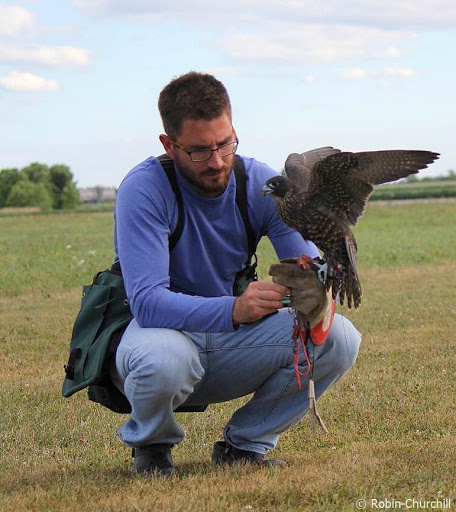 |
| Shaq and Robin |
Having worked as
for a wildlife management company in Canada that specializes in the use of
falconry to deter nuisance wildlife, I've seen my fair share of amazing wild
interactions. However, what probably hooked me on the sport more than anything
was Shaq, a Gyr/Barbary falcon hybrid.
In those days (a
much-less experienced falconer), I subscribed to the "overwhelm the bird with
everything you got" method – he sat on a perch in the middle of my kitchen
with people and dogs around all the time.
Throughout the
process, your aim is to get the falcon to the point where hunger overcomes
fear. This does not mean falconers starve their birds - a common misconception.
Each falconer takes special care to ensure this doesn't happen by spending
countless hours with the bird, building a relationship of trust. When that
level of trust finally allows for the falcon to eat food offered by the
falconer, the real training begins. The falcon’s body weight is monitored
multiple times daily to provide an indication of the bird's hunger level. A fat
bird simply will not perform.
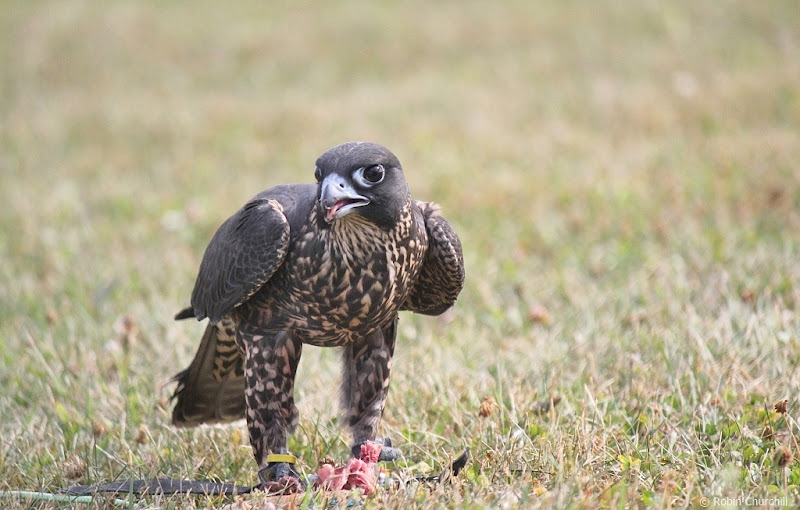 |
| Shaq - a Gyr-Barbary Falcon |
Starting with full
meals from the glove of the falconer, you quickly want to switch the main food
source from hand to lure. The small leather lure is used as the main tool for
retrieving a falcon that hasn't succeeded in catching its quarry and becomes
the most important tool. From here your goal is to: 1. improve the flying skill
of the falcon 2. build up the flight muscles of the falcon and 3. introduce the
falcon to quarry. In Shaq's particular case I chose to achieve 1 and 2 through
the use of a kite. By tying his lure to the kite line and sending the kite up
into the sky, I was quickly able to teach Shaq to go higher and higher in the
sky, improving his flight and fitness.
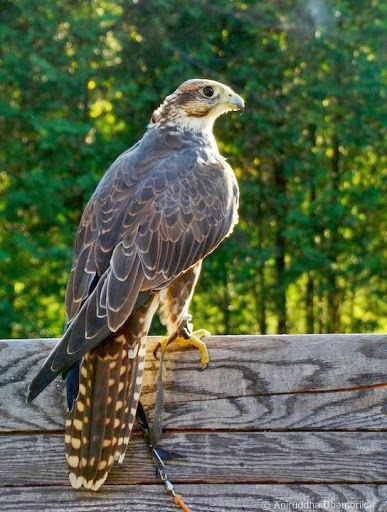 |
| Sugar - a Gyr-Saker Falcon. 2010. |
Why is this
important? Falcons hunt in such a way that typically requires them to take a
high pitch. That is, they rely on high position in the sky for the ability to
seek out prey that could be miles away, as well as being able to stoop and hit
prey that can be potentially twice their size. For a high-flying falcon to be
successful with a falconer, and provide the falconer with the greatest show on
earth, this high pitch is very important. With enough muscle and flying
experience from the kite, Shaq was quickly able to learn about quarry.
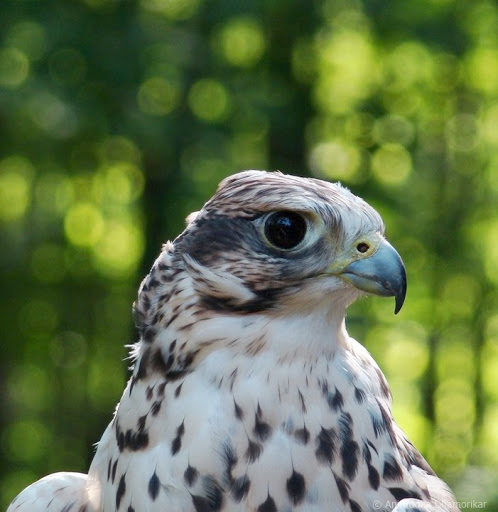 |
| Sugar gazing at Robin. Her keen dark eyes crowned by distinct orbital ridges, and a hooked beak made her an efficient hunter - and an avid learner. 2010. |
Racing pigeons can
be a very important tool for falconers training falcons. They teach the bird
how to properly position themselves in the sky to be successful. Even the best
falcons have a hard time catching racing pigeons, when they miss, they go
higher and straighter up to have a better shot the next time they get the
opportunity. In the early stages I would throw maybe 2-3 racing pigeons for
Shaq to get him hooked, followed by a common pigeon that he could easily catch
- positive reinforcing the pigeon hunt. This quickly escalated to 3-4 pigeons
when he had enough muscle to sustain that amount of flying (stooping 1500 ft and
re-mounting isn't easy!). By this time he had learned the game enough that if a
racing pigeon made any mistakes, it would be caught. He was regularly flying 1000-1500 ft
up a few times a day.
[Note: Hunting in Canada is legal under
specific terms and conditions. The author is a resident of Canada and a
licensed falconer, and shares his experiences from his homeland.]
| A wild Merlin hunts a Savannah Sparrow in the Carolinas of Manitoulin Islands, Ontario, Canada. 2010. |
There truly is
nothing on this Earth as amazing as a falcon’s stoop. The speed and
acceleration at which they come barreling towards the ground at is actually
indescribable. Words do not do it justice. I was privy to this amazing feat
multiple times nearly every single day and could not get enough of it. While
flying and catching bagged quarry (pigeons that I serve him) is incredibly
entertaining, I knew the real fun would come hunting wild quarry. Living where
I do in Ontario, the only real option for Shaq was ducks. When Shaq switched to
catching ducks, the real fun began.
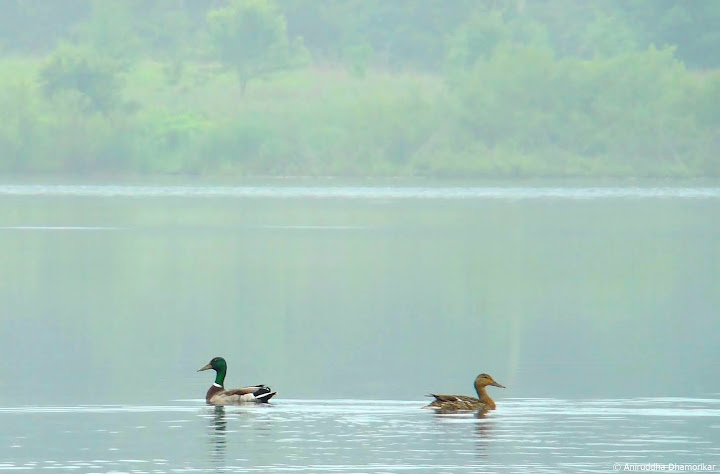 |
| A pair of Mallard ducks in one of the quaint little lakes in Ontario. 2010. |
A typical hunt
scenario for a falcon like Shaq goes like this: 1. find a suitable sized
(smaller the better, surrounded by land) pond with ducks in it. Be careful of
the surroundings as you can hardly ever predict where the chase will happen
(power lines, roads, buildings, fences are all issues). 2. Get a safe distance
away from the pond - you don't want to scare the ducks away with the commotion
involved with letting the falcon go 3. Let the falcon go 4. Wait until the
falcon is in position then rush the pond as fast as you can (with no regard for
human safety) screaming and carrying on like an idiot to get the ducks to
leave. 5. Watch the stoop and wait for a cloud of feathers at the end of it!
The best stories I
have of Shaq always involve wild falcons coming in to ruin a hunt. A few
particular stories stick out in my mind. While hunting Shaq in Ottawa we chose
a small stream next to a horse farm to hunt. There were probably 20 ducks in
the stream, with a fair number of obstacles around. Our plan was to get the
ducks to flush away from the obstacles and out over the horse pasture. Easier
said than done. Ducks (and any birds for that matter) somehow become incredibly
intelligent when a falcon is around. For those of you who have no experience
with falconry - believe me when I tell you, most birds are not easy to catch.
They are way smarter than they show humans - think ducks in a park. These
particular ducks, knowing a falcon was about to hit one of them at over 100 mph,
decided their best defence was to fly low along the stream and not over the
pasture. This didn't stop Shaq from chasing them down the stream full speed,
what did stop him was a wild female Peregrine falcon that wanted a piece of the
action. She too came right in behind the ducks trying her best to knock one
down. All of this occurred maybe 30 ft in front of me!
Once both falcons
had decided they lost, they switched their attention to each other. Watching a
dog fight 100 ft off the ground between two strong falcons is quite a sight. The
female peregrine was nearly twice Shaq's size. Shaq flew at 550 grams, that
Peregrine was likely in the neighbourhood of 900 grams. This certainly didn't
deter Shaq from trying to chase her away from "his" spot. After about
5 solid minutes of both birds trying to hit one another, the female Peregrine
decided it was enough for her and flew off. I called Shaq down with the lure
and he was panting like a dog from all the effort exerted. If anything, he got
his exercise for the day!
Another time I was
flying Shaq near the abandoned airport that I often used to train falcons at.
On this particular day I was going to go serve him a bagged duck. I was
determined to serve him the duck when he was climbing hard, to teach him that
good things happen when he is really pumping to gain more altitude. I
personally have a hard time with being greedy when training a falcon - that is,
I will sometimes hold out for something better than originally planned - rather
than just teach the simple lesson I set out to teach. Of course, that happened
on this day. He was climbing incredibly hard and I could've served him on
multiple occasions but didn't, I wanted to see how high he was going to go! The
issue with this is that you risk serving him after he's quit climbing and just
coasting around way up there, not teaching him anything useful. My greed wasn't
a fault this time. Just before I wasn't able to see him any more (usually north
of 1500') I was able to serve the duck while he was still working at it! Now
the second issue when using bagged ducks, is that they don't all fly as well as
you would like them. Sometimes they come out of the launcher and fly 10' and
give up!
Again, on this day,
I got lucky, and got a really strong flier. The duck took off fast and was
climbing hard straight downwind of Shaq's position. When he winged over into
the stoop the duck was already 25' up off the ground and moving. I lost sight
of Shaq because of the angle he was coming down at so I knew to immediately
switch focus to the duck, I picked Shaq up when I heard him sizzling through
the sky (Yes - you can actually hear them cutting through the wind). He was
moving faster than I had ever seen him move and the stoop took longer than
usual due to his higher-than-normal position.
When he finally hit
the duck, it was directly in the back of the head, killing it on impact. Now,
that typically would have made my day, but I got a bonus this particular time.
A wild tiercel Peregrine came stooping out of the heavens right behind Shaq and
drilled the duck before it even managed to hit the ground! By the time the duck
hit the ground, both falcons were coming in hot to claim their prize.
Knowing the danger
another raptor can present, I immediately started sprinting towards them. The
two falcons were wrestling each other on the ground when I got there, but the
wild bird took off as soon as I arrived. Shaq, no worse for wear, hopped onto
the duck and finished his daily meal. What a rush!
---
About the Author: Robin Churchill
Robin is a graduate from University of Western Ontario, and a
Biologist at Predator Bird Services, Canada. He’s an expert falconer, and has
conducted research on the distribution and abundance of submerged aquatic
vegetation and dreissenid mussels in the inner Long Point Bay, Lake Erie. He’s
an avid ethical hunter, trainer of dogs, and a fierce conservationist; prefers to spend time in the wild, and is rare to find on social media. His work has been showcased here.
---
This work is © Robin Churchill and has been published with his
permission. All the views expressed in this article are that of the author. No
part of this article can be used without prior permission of the author. Please
write to me for more information.
Comments
Post a Comment